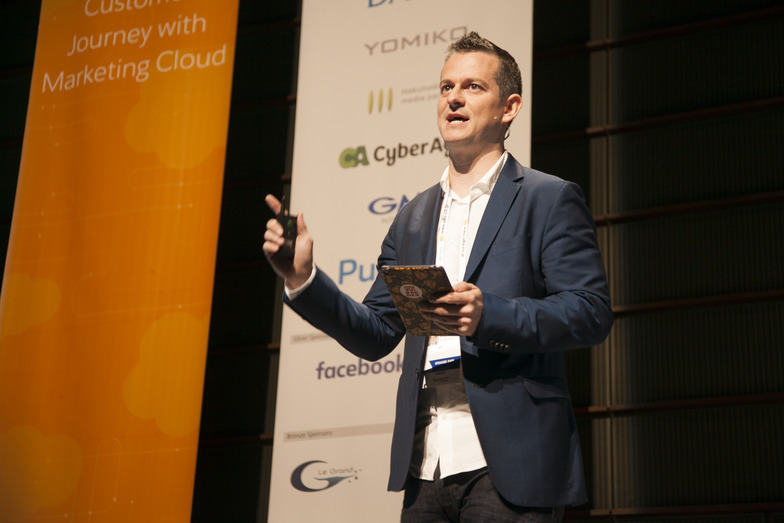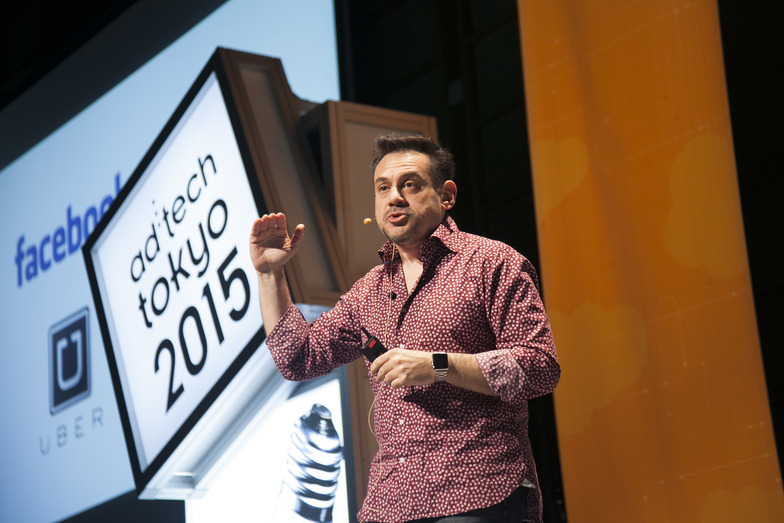Note: This website was automatically translated, so some terms or nuances may not be completely accurate.
【AdTech Tokyo 2015】 Can Digital Technology Reach the Essence of Humanity? Learning from Global Trends for 2016 Marketing Strategy

On December 1st and 2nd, the international digital marketing conference "AdTech Tokyo 2015" (hosted by ComExpo Japan) was held at the Tokyo International Forum in Chiyoda Ward. This seventh iteration featured 113 first-time speakers among its 182 official speakers. How can we confront the rapid changes in the business environment through digital means? Attendees listened intently to six keynote speeches offering bird's-eye perspectives and detailed discussions by leading players, while the exhibition floor bustled with activity.
Content is now democratized
The first keynote speaker was Scott Spiritt, who serves as both Chief Digital Officer and Chief Strategy Officer at WPP. He identified three trends impacting the advertising industry: content, technology, and data.
"In the past, a select group of professionals created and distributed content, and we effectively placed ads within that content to convey our messages. But that era is over. It's fair to say the concept of content has been democratized," stated Spirit. He suggested that companies and agencies must now delegate brand power to influencers, and sometimes even to consumers themselves.
Regarding technology, he explained that the ad tech landscape, once a literal "chaos map" of fragmented segments and proliferating players, has now consolidated into a two-horse race dominated by Facebook and Google. WPP plans to counter this through its programmatic advertising platform, Xaxis. "Our dealings have expanded from CMOs to CIOs, while our competitive landscape is also changing. Consulting firms like Deloitte and Accenture are now increasingly becoming competitors, even as they remain our clients and partners."
Regarding the third point about data, Spirit emphasized, "Big data is not just a catchphrase; it's a real opportunity for companies and agencies," introducing the company's ongoing focus on data.

The latter half of the keynote featured a talk session with Daisuke Otonabe, who joined Shiseido Japan as CMO this year after stints at P&G and Unilever. Otonabe described this major digital transition at Shiseido, a traditional brand company, as a "significant opportunity." "But at the same time, if we cannot use new technologies appropriately, it also becomes a threat," he stated. Currently, we are working on how to unlock the knowledge of digitally savvy individuals within the organization."
Post-Demographic Era: Capture Individuals Digitally
Henry Mason, Managing Director of Trendwatching, which employs over 3,000 global "trend spotters," delivered a keynote titled "Deliver Results or Get Out: Decoding Consumer Trends for 2016 and Beyond."
"For example, mobile changed the world, but human nature remains unchanged," he stated. "Even on YouTube, how-to content is popular; videos like 'How to Kiss?' get huge views. Businesses must apply these fundamental insights to their own operations. Furthermore, people increasingly expect the same level of convenience they find in one industry to be available in others." He emphasized, "Customers don't care about industry boundaries. Expectations migrate," illustrating this with the concepts behind Uber and Amazon Dash Button.
As a specific trend for interpreting 2016, Mason declared "demographics are dead," championing "Post-Demographic Consumerism." People's lifestyles and identities are becoming more fluid and flexible, increasingly defined from the consumer's perspective. "Our capabilities are expanding through convenient devices and apps. Furthermore, even in Japan, often considered a conservative society, events like the Shibuya Gay Pride Parade demonstrate growing social tolerance. The equation that status equals owning expensive things has also broken down."
Catching these trends, forward-thinking companies are already in motion. Examples include Versace, which launched a collection featuring a hip-hop musician popular with younger audiences, and Burberry, which ran a campaign with LINE – even touching the sacred brand itself.
So, how can digital contribute in this post-demographic era? Mason emphasized, "The ability to capture the 'individual' offers us greater opportunities than ever before. Start with small digital campaigns." He cited Spotify, the music streaming service, which analyzes user data and sends personalized playlists weekly to boost engagement, calling this the very essence of a post-demographic strategy.

Four Factors Driving the "Rewrite"
Leonard Brody, founder of GrowLab and an entrepreneur and investor, opened his keynote by stating, "The 'Great Rewrite'—the world is entering an era of profound transformation."
Alongside supporting ventures and launching startups worldwide, Brody develops digital initiatives at U.S.-based Anschuz Corporation, which operates in sports and entertainment. At the 2014 Billboard Music Awards, he brought Michael Jackson back to life on stage via hologram. "By 2020, approximately 30% of live entertainment revenue will come from non-human sources," Brody stated. This too represents one of the major rewrites.
Four key drivers are propelling this shift. First, technology. As technology becomes more widespread, the cost of innovation approaches zero. Second, consumer behavior. "Our core elements remain the same, but the existence of virtual identities creates a 'one person, two identities' situation," Brody explains.
Third, capital markets. Moves by investment banks are bringing unexpected competitors from other industries. And fourth, the rise of entrepreneurs. As job automation advances, the era of employment is nearing its end, driven primarily by young people seeking freedom.
In a world where every system and value is being rewritten, where should marketers find their path forward? Brody suggests one approach: the "Parallel Enterprise"—starting another company alongside the main business entity. "To achieve one success, a company must endure ten failures. Yet people cannot act boldly under realistic goals and deadlines. I hope you will dedicate 10% of your current resources to establishing a parallel enterprise," he expressed his expectations.

Multiple themes explored through the lens of mass media × digital
Over the two afternoons, 45 official sessions unfolded across five tracks. While themes spanned mobile, data, and creative, pinpoint topics like the Chinese market and Millennials—areas with promising future growth—were also featured.
The session "Considering Long-Term Digital and Mass Effect Measurement in TV-Centric Japan" featured panelists from Coca-Cola Japan, Nissan Motor, Nippon TV, and Dentsu Inc. Discussions included the social media teaser campaign for "Iroha-su Momo" and the rollout of the "Go for it, NISSAN!" TV commercial focusing on autonomous driving. Nippon TV introduced tracking using HAROiD tags within the "Friday Road Cinema Club," the fan club for Friday Roadshow.
Regarding "Digital × Mass," the session also explored commonalities and differences between web ads and TV commercials. In "Which Way Will Web Ad Videos Go?", insights from the TV commercial side discussed integration and possibilities with web ads. This included the creative intent behind "Ninja High School Girl" (Suntory) and "high school girl? The Secret of Makeup High School Girls" (Shiseido), along with behind-the-scenes stories from the production of "Sanpol 'The Word Goodbye' Long Version" (Dai-Nichi Co., Ltd.).

This time, two investors also took the stage for the keynote, and the theme "Collaboration with Startups Opens New Paths" was explored in the official session. Discussions on co-creation between startups and large corporations unfolded from various perspectives—entrepreneurs, supporters, and both sides working together.
Additionally, on both days of the official sessions, one of the five tracks was designated as the International Stage, featuring participation from players both domestic and international.
As Mason stated, "The customer doesn't care about industries." When envisioning the future from the customer's perspective, marketers must seek opportunities beyond their roles and themes. Naturally, this includes a global outlook and collaboration. While digital accelerates and deepens, the session also underscored the importance of not being confined by "digital" itself.
Was this article helpful?